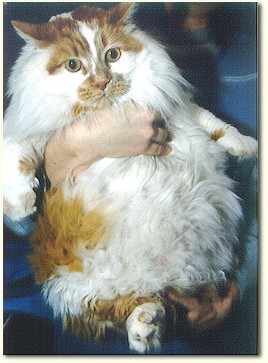 Most everyone recalls that old doctored photo of a man holding a cat the size of a German shepherd in his arms while smiling at the camera from the warmth of his living room. Although that photo was most certainly a fake, obesity in cats can be a real problem. This condition presents its own set of problems, but there are some solutions.
Most everyone recalls that old doctored photo of a man holding a cat the size of a German shepherd in his arms while smiling at the camera from the warmth of his living room. Although that photo was most certainly a fake, obesity in cats can be a real problem. This condition presents its own set of problems, but there are some solutions.
One of the easiest and most logical steps (or at least a move in the right direction towards a solution) is to realize that the fat cat in your home got that way because it is consuming too much food. While this revelation may not win you a Nobel Prize for outstanding research in the field of investigative science, it will help you to create a situation that is healthier for the cat. Many cats are fed “freely,” (including mine), which means that food is available at all times and that the cat can eat whenever it wants. Feed your obese cat two to six small portions daily instead.
Preserved dry foods are culprits in this obesity chain as well. They are convenient, which is why cat owners succumb to them. Unfortunately, most dry food, in order for the kibble to stay uniform, contains high levels of flour and sugar. Preservatives prevent spoiling and reduce the number of meals that need to be prepared.
It should also be said that according to multiple research studies, a cat’s diet should be consistent with that of any carnivore in order to be healthy. This means it must be meat-based. Consider the diet of the feline in a feral state; birds and mice are regular fare. An ideal feline diet will contain a protein level of 35-45%. Cats cannot process large amounts of carbohydrate the way dogs and humans can, and too much intake can become a prelude to diabetes.
Do YOU have an obese cat? Please share your experiences.
Related Articles:
“Making Your Own Cat food: Should You Or Shouldn’t You?”
http://pets.families.com/blog/making-your-own-catfood-should-you-or-shouldnt-you

